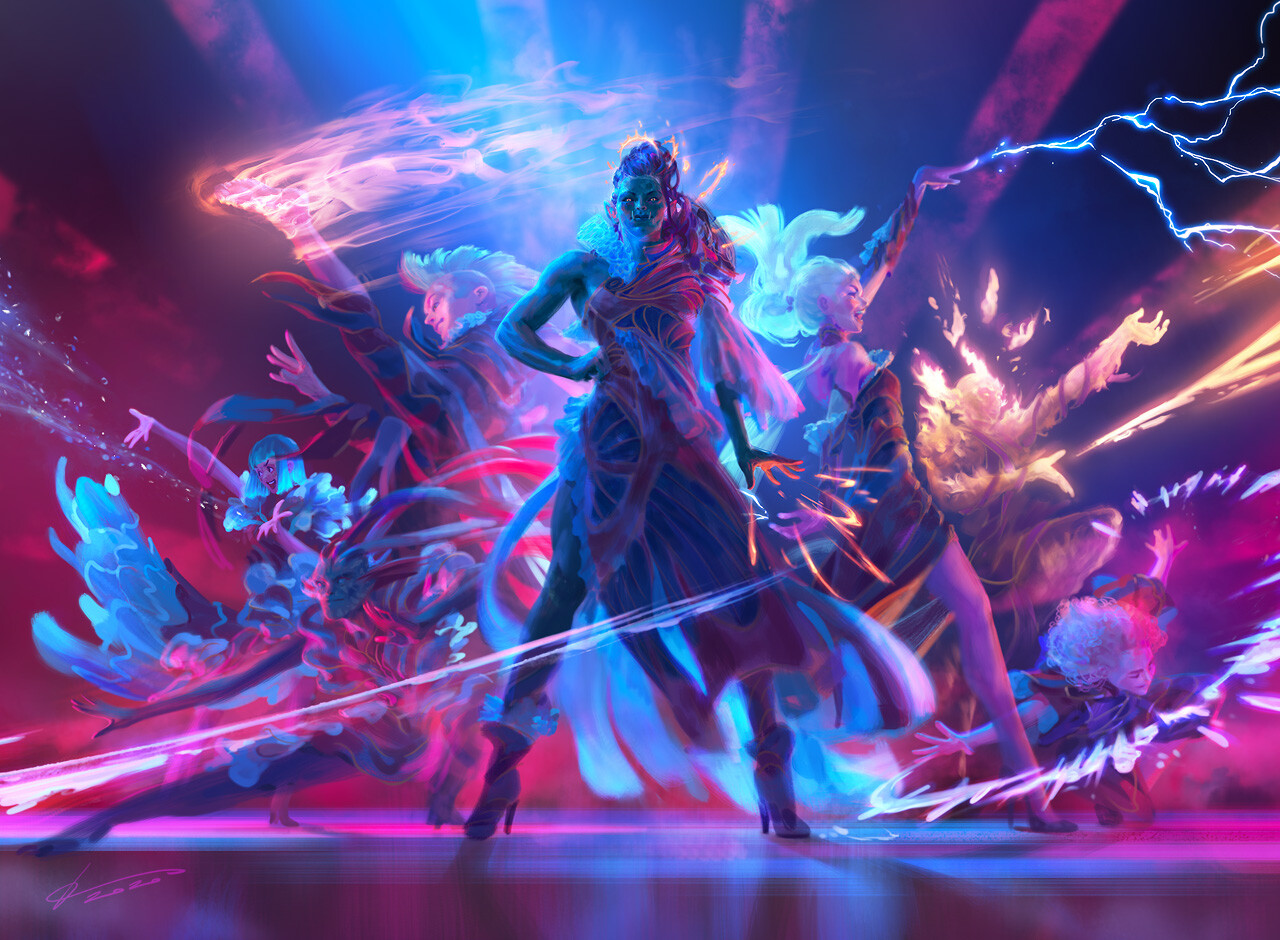
Unearthed Arcana: Mages of Strixhaven, Part 4
Previously in this series, we applied our revised vision of the cross-class subclass model to the Mage of Lorehold subclass, arriving at an iteration that achieves a unique and cohesive subclass identity whilst maintaining each class's individual subclass design philosophy.
This time around, we take a look at Prismari!
Mage of Prismari, Revised

Illustrated by Johannes Voss
The table below sets out the features that each class in the Mage of Prismari subclass receives at certain levels. Certain features are shared across all classes, whilst specific features are specific to certain classes.
Level | Bard | Druid | Wizard | Sorcerer |
1+ | Prismari Spells, Creative Skills, Kinetic Artistry | |||
6+ | Spectacle Mage | |||
10+ | - | Expressive Iteration | - | |
14+ | Impeccable Physicality | |||
18 | - | Vortex Virtuoso | ||
Prismari Spells
Level 1+ Mage of Prismari Feature (all)
You learn the cantrip create bonfire and the 1st-level spell fog cloud. You learn additional spells when you reach certain levels in this class, as shown on the Prismari Spells table.
Each of these spells counts as a class spell for you, but it doesn’t count against the number of spells you know. If you are a druid, you always have the spells prepared, and they don’t count against the number of spells you can prepare each day. If you are a wizard, you can add these spells to your spellbook upon learning them, without expending any gold, and prepare them as normal.
Prismari Spells
Class Level | Spells |
3rd | flaming sphere, scorching ray |
5th | lightning bolt, sleet storm |
7th | storm sphere, ice storm |
9th | cone of cold, elemental summoning |
Creative Skills
Level 1+ Mage of Prismari Feature
You gain proficiency in two of the following skills of your choice: Acrobatics, Athletics, Nature, or Performance.
Kinetic Artistry
Level 1+ Mage of Prismari Feature
You can Dash as a bonus action. When you take this bonus action, choose one of the following additional effects:
- Boreal Sweep. Icy water swirls around you. Until the end of your turn, you can move across the surface of water as if it were harmless solid ground. Additionally, when you leave a space within 5 feet of a creature, you can force that creature to make a Strength saving throw against your spell save DC. On a failed save, the creature is knocked prone. A creature can be affected by the water only once each turn.
- Scorching Whirl. You leave a trail of sparks in your wake, which burn until the start of your next turn. When a hostile creature moves through your trail, it must make a Dexterity saving throw against your spell save DC. On a failure, a creature takes fire damage equal to 1d4 + your spellcasting modifier.
- Lightning Jaunt. Your form momentarily phases into electric energy. Until the end of your turn, you can move through the space of other creatures, and you do not provoke opportunity attacks. If you end your turn inside a creature’s space, you are pushed into the nearest unoccupied space.
- Crashing Thunder. Your footfalls reverberate with thunderous force. Until the end of your turn, when you enter a space within 5 feet of a creature, you can force that creature to make a Strength saving throw against your spell save DC. On a failed save, you can push that creature 5 feet away from you.
You can use this bonus action once, and you regain the ability to do so when you finish a long rest, or when you meet certain conditions, depending on your class.
Bard. When you give a creature a Bardic Inspiration die, you regain the ability to use your Kinetic Artistry feature. Additionally, that creature can expend the die as a bonus action to use your Kinetic Artistry feature. When it does so, it rolls the die and gains the result as a bonus to its AC until the end of its turn. If any creatures are forced to make saving throws in this way, use your spell save DC.
Druid. As an action, you can expend one use of your Wild Shape feature to become attuned to one of the elemental mediums that you use in your art. Choose one of the following damage types: cold, fire, lightning or thunder. You gain the following benefits:
- You gain resistance to the chosen damage type.
- At the start of each of your turns, you regain the ability to use your Kinetic Artistry feature.
- When you cast a spell using a spell slot that deals the chosen damage type, you gain temporary hit points equal to the level of the spell slot plus your proficiency bonus.
The attunement lasts for 10 minutes. It ends early if you dismiss it (no action required), are incapacitated, die, or use this feature again.
Sorcerer, Wizard. When you cast a spell of 1st level or higher, you regain the ability to use your Kinetic Artistry feature.

Illustrated by Kieran Yanner
Spectacle Mage
Level 6+ Mage of Prismari Feature
While you are concentrating on a conjuration or evocation spell of 1st level or higher, you have a flying speed equal to your walking speed, and can hover. If you are flying, you must end your turn within 10 feet of the effect your spell creates, or you fall to the ground.
When you cast a conjuration or evocation spell of 1st level or higher with a duration of instantaneous that deals cold, fire, lightning or thunder damage, choose any number of friendly creatures within 60 feet of you that can see you, up to the level of the spell slot you used. Until the start of your next turn, the first time each of those creatures deals damage, they deal additional cold, fire, lightning or thunder damage (depending on the spell’s damage type) equal to your proficiency bonus.

Illustrated by Anastasia Ovchinnikova
Expressive Iteration
Level 10+ Mage of Prismari Feature (Druid and Wizard only)
Whenever a spell you cast with a spell slot would deal cold, fire, lightning or thunder damage, you may have it deal one of the other types of damage. Additionally, when a spell you cast with a spell slot would force a creature to make a Strength, Dexterity or Constitution saving throw, you may force it to make one of the other types of saving throws.
Impeccable Physicality
Level 14+ Mage of Prismari Feature
Your relentless dedication and training have instilled an outstanding sense of precision and grace in your art. You gain proficiency in Dexterity saving throws if you do not already have it. Additionally, when you make a Dexterity saving throw, you can treat a d20 roll of a 9 or lower as a 10.
Vortex Virtuoso
Level 18 Mage of Prismari Feature (Sorcerer only)
When you cast a spell, you can choose not to be affected by it. Additionally, while you are concentrating on a conjuration or evocation spell of 1st level or higher, you can spend a sorcery point as an action to reinterpret your artwork, altering the spell in one or more of the following ways:
- If the spell is centered on a point or area, you can move its center to another point or area within range.
- You may alter any decisions you made while casting the spell. For instance, you could change the shape of a wall of fire, or the type of elemental summoned by elemental summoning.
Design Notes
The original Mage of Prismari design was too focused on the elemental side of Prismari, without giving due attention to the theme of art and expression. Further, as noted previously, Bards were not included in the college that was all about using magic to express one's emotions and artistry, which was a clear flavor fail. The revised version addresses these issues, while retaining the aspects of the original design which worked well.
Kinetic Artistry was an interesting concept that granted a unique mobility boost and a bonus action filler to full casters at an early level. The revised version adds thunder to the elements that can be chosen from, and tweaks the fire option to bring across the theme of art more clearly - now you can draw trails of sparks on the battlefield with your movement!
Furthermore, the revised Kinetic Artistry was used as an opportunity to showcase how class-specific features could be used to explore variations on a common theme. The original Kinetic Artistry could be used PB times/long rest, whilst the revised version can be used once per long rest, but is refreshed when you meet certain conditions, depending on your class.
Spectacle Mage replaces the previous 6+ feature, Favored Medium, which didn't really capture the flair of Prismari. Here, the schools of conjuration and evocation reflect the types of spells that Prismari mages will be concentrating on the most often, thus requiring players to adapt their playstyles accordingly. The payoff for doing so is well worth it - a fly speed whilst you're concentrating on an ongoing effect is something many casters would love to have. The condition (concentrating on conjuration or evocation spells) and the reward (flying) both reinforce the Prismari flavor of soaring above the magical tempest you've crafted.
Expressive Iteration replaces Focused Expression as the 10+ feature. Expressive Iteration uses the elements as a canvas to serve the mage's creativity and expression, enabling them to take existing spells and put their own individual twist on them.
Impeccable Physicality was a satisfactory capstone that granted something unique to casters, much like Kinetic Artistry, so it was retained.
Vortex Virtuoso, as the level 18 capstone feature for Sorcerers, had to achieve two goals. Firstly, it had to build on the design elements that the previous Prismari features had established. Secondly, it had to be in line with other Sorcerer subclass capstones, which typically involve a flashy effect that can be repeated by spending sorcery points. Vortex Virtuoso builds on the theme of concentrating on conjuration/evocation spells that was introduced in Spectacle Mage, and echoes Expressive Iteration (without copying it) in how it allows the mage to creatively adapt their spells. This is achieved through the expenditure of sorcery points, in line with Sorcerer subclass design.
If there's one lesson that has become more apparent throughout the course of revising the Strixhaven subclasses, it is that one must not lose sight of the purpose behind using cross-class subclasses as opposed to conventional subclass design. Cross-class subclasses are not a gimmick to be used for their own sake - they serve the purpose of conveying a theme in the medium of mechanics. What cross-class subclasses enable designers to do is play with variations on that common theme - the shared subclass identity and features establish the theme, while class-specific features and resources provide angles to execute variations on.
Could this be done with conventional subclass design? Possibly. In fact, the Mage of Prismari subclass could even be construed as four seperate subclasses which just happen to have certain features in common, if that's easier to parse. Being able to share certain features both economizes on effort and creates a stronger thematic link between the classes that share the same subclass, making cross-class subclass design well worth developing and exploring further.
Thanks for reading this article! If you have thoughts on the subject, feel free to share them with us on the Twitter thread - let's start a conversation!
Do follow us on Twitter or Facebook to receive an update when the next one goes live, and/or sharing it to your friends with the links below!
